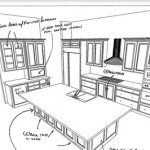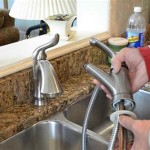How to Replace a Fluorescent Light Fixture in a Kitchen Island
Kitchen islands often serve as a central hub for meal preparation, casual dining, and social gatherings. Proper lighting is essential to effectively utilize this space. Over time, fluorescent light fixtures, commonly found in kitchen islands, may degrade, flicker, or fail altogether. Replacing a fluorescent fixture with a new one or upgrading to a more energy-efficient LED option can significantly improve the functionality and aesthetics of the kitchen.
This article provides a comprehensive guide on how to safely and effectively replace a fluorescent light fixture in a kitchen island. It covers the necessary tools and materials, step-by-step instructions, and essential safety precautions to ensure a successful installation. The process, while generally straightforward, requires careful attention to detail and adherence to electrical safety guidelines.
Preparing for the Replacement
Before commencing any electrical work, thorough preparation is crucial. This involves gathering the necessary tools and materials, disconnecting the power supply, and understanding the existing wiring configuration.
First, assemble the required tools. These typically include:
* A non-contact voltage tester: This device is essential for verifying that the power to the fixture is completely shut off before touching any wires. * A screwdriver set: Both flathead and Phillips head screwdrivers are necessary for removing the old fixture and installing the new one. * Wire strippers: These are used to safely remove the insulation from electrical wires without damaging the copper conductor. * Wire cutters: Useful for trimming wires to the appropriate length. * Pliers: For gripping and manipulating wires, especially when making connections. * Electrical tape: Used to insulate wire connections and prevent short circuits. * Safety glasses: To protect your eyes from debris. * Work gloves: To provide a better grip and protect your hands. * A ladder or step stool: To safely reach the fixture. * A new light fixture: Ensure the replacement fixture is compatible with the existing wiring and the intended use of the kitchen island. Consider the size, style, and light output of the new fixture. * Wire connectors (wire nuts): These are used to securely connect the electrical wires.After gathering the tools, the next critical step is to disconnect the power supply to the fixture. Locate the circuit breaker that controls the kitchen island lighting in the electrical panel. Turn the breaker to the "OFF" position. To double-check that the power is completely off, use the non-contact voltage tester. Hold the tester near the existing fixture and any exposed wires. If the tester indicates the presence of voltage, double-check that the correct breaker is off. If the tester still indicates voltage, consult a qualified electrician.
Before removing the old fixture, carefully examine the wiring configuration. Note the color and arrangement of the wires connected to the fixture. Typically, there will be a black wire (hot), a white wire (neutral), and a green or bare copper wire (ground). Taking a photograph of the wiring configuration can be helpful for reference during the installation of the new fixture. This photograph serves as a visual aid and minimizes the risk of incorrect wiring.
Removing the Old Fluorescent Fixture
With the power safely disconnected and the wiring configuration documented, the next step is to remove the old fluorescent fixture. This process typically involves disassembling the fixture, disconnecting the wires, and removing the mounting hardware.
Begin by removing the light bulbs or tubes from the fluorescent fixture. Handle these bulbs carefully, as they contain mercury and can break easily. Dispose of the old bulbs according to local regulations for hazardous waste. Next, remove the diffuser or lens covering the bulbs. This is usually held in place by clips, screws, or tabs. Once the diffuser is removed, the internal components of the fixture, such as the ballast and wiring, will be exposed.
Carefully disconnect the wires from the old fixture. Using the screwdriver, loosen the wire connectors (wire nuts) that connect the fixture wires to the house wiring. Gently pull the wires apart. If the wires are corroded or brittle, use wire strippers to trim the ends and expose fresh wire. Ensure that the wires are not frayed or damaged. If the wires are too short to connect to the new fixture, consult an electrician to extend them safely.
After disconnecting the wires, remove the mounting hardware that secures the fixture to the ceiling or cabinet. This may involve unscrewing screws, bolts, or clips. Support the fixture with one hand while removing the mounting hardware to prevent it from falling. Once the mounting hardware is removed, carefully lower the fixture and set it aside.
Inspect the junction box in the ceiling or cabinet where the fixture was mounted. Ensure that the box is in good condition and securely attached. If the box is damaged or loose, it should be repaired or replaced before installing the new fixture. Also, make sure that the wires coming from the junction box are in good condition and have sufficient length for connecting to the new fixture.
Installing the New Light Fixture
With the old fixture removed and the wiring inspected, the final step is to install the new light fixture. This involves mounting the fixture, connecting the wires, and testing the installation.
Begin by mounting the new fixture to the ceiling or cabinet. Follow the manufacturer's instructions for the specific fixture being installed. Typically, this involves attaching a mounting bracket to the junction box and then securing the fixture to the bracket. Ensure that the fixture is securely mounted and level. If the fixture is not level, it can appear crooked and detract from the overall appearance of the kitchen.
Next, connect the wires from the new fixture to the house wiring. Match the wires according to color: connect the black wire from the fixture to the black wire from the junction box, the white wire from the fixture to the white wire from the junction box, and the green or bare copper wire from the fixture to the green or bare copper wire from the junction box. Use wire connectors (wire nuts) to securely connect the wires. Twist the wires together clockwise, place the wire connector over the twisted wires, and twist the connector until it is snug. Gently tug on each wire to ensure a secure connection. Wrap the wire connectors with electrical tape for added insulation and security.
Carefully tuck the wires into the junction box, ensuring that they are not pinched or damaged. Replace any covers or plates that were removed during the disassembly process. Install the light bulbs or tubes in the new fixture, following the manufacturer's instructions. Replace the diffuser or lens covering the bulbs.
After the fixture is fully installed, turn the circuit breaker back to the "ON" position. Test the new fixture by turning the light switch on and off. If the fixture does not turn on, immediately turn the circuit breaker off and recheck the wiring connections. Ensure that all wires are securely connected and that there are no loose strands of wire touching each other. If the fixture still does not work after checking the wiring, consult a qualified electrician.
If the fixture turns on, observe it for a few minutes to ensure that it is operating correctly. Check for any flickering, buzzing, or other unusual noises. If anything seems amiss, turn the circuit breaker off and investigate the issue further. Once satisfied that the fixture is working correctly, clean up any debris and dispose of the old fixture properly.
Upgrading a fluorescent fixture to an LED fixture requires similar steps, but it’s crucial to ensure compatibility. Some LED fixtures are designed as direct replacements for fluorescent fixtures, while others may require modifications to the wiring. Always consult the manufacturer’s instructions for the specific LED fixture being installed. In some cases, the ballast may need to be bypassed or removed for the LED fixture to function correctly. Improper installation of an LED fixture can result in damage to the fixture or create a fire hazard.
Replacing a fluorescent light fixture in a kitchen island can be a straightforward project with careful planning and execution. However, electrical work can be dangerous if not performed properly. If unsure about any aspect of the process, it is always best to consult a qualified electrician for assistance. Prioritizing safety and following best practices ensures a successful and long-lasting installation.

How To Replace An Old Fluorescent Light Fixture Young House Love

Removing A Fluorescent Kitchen Light Box The Kim Six Fix

Removing A Fluorescent Kitchen Light Box The Kim Six Fix

How To Replace An Old Fluorescent Light Fixture Young House Love

How To Replace An Old Fluorescent Light Fixture Young House Love

Replacing Fluorescent Light Boxes In Your Kitchen My Design Rules

How To Remove Fluorescent Ceiling Light Box

Removing A Fluorescent Kitchen Light Box The Kim Six Fix

What Light Fixture Do I Use To Replace Kitchen Fluorescent

How To Replace An Old Fluorescent Light Fixture Young House Love
Related Posts








